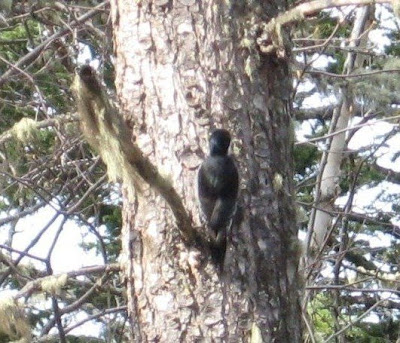The woods at three thirty in the afternoon of a sunny warm day had been very still.
I was just coming back from a walk when I heard pik, pik, pik being repeated over and over. The sound came from a woodpecker clinging to a spruce tree located to the right of the trail and on the hillside.
I was just coming back from a walk when I heard pik, pik, pik being repeated over and over. The sound came from a woodpecker clinging to a spruce tree located to the right of the trail and on the hillside.
 It turned out to be a female
It turned out to be a femaleBlack-backed Woodpecker (Picoides arcticus),
identified later with the help of my photos.
yellow in male. Similar to the Three-toed Woodpecker
in that the Black-backed also has three toes on each foot.
 As I took pictures, the woodpecker, which is about the
As I took pictures, the woodpecker, which is about thesize of a robin, continued to move up the tree
and then sidled around to the back when
I got closer and was detected.

One of the things I found out about this uncommon woodpecker is that they depend, to a large degree, on the larvae of bark boring beetles for their diet. They prefer burned areas where there are plenty of dead trees and beetle larvae. Although our forests in this region are relatively intact in terms of being decimated by fire, much of the lodgepole pine forests in the central interior of British Columbia have been destroyed in recent years by the mountain pine beetle.
 This pine was once a healthy tree
This pine was once a healthy treeuntil the mountain pine beetle infestation.
The beetle has always been around, but
these epidemic proportions have been directly
attributed to milder winters and wildfire
(one of the ways nature cleanses the forest)
suppression.
 Flakes of bark at the base of this dead pine
Flakes of bark at the base of this dead pine
indicates the presence of woodpeckers
The beetle has always been around, but
these epidemic proportions have been directly
attributed to milder winters and wildfire
(one of the ways nature cleanses the forest)
suppression.
 Flakes of bark at the base of this dead pine
Flakes of bark at the base of this dead pineindicates the presence of woodpeckers
foraging for larvae and insects.

